Praying Mantises are known for their raptorial front legs. These small bugs are some of the most efficient camouflaging predators.
Southern US states are among the areas where they are present in high numbers.
Different species of Praying Mantises live across The United States and North America. Some of the most common you can likely spot in nature include the following species.
Table of Contents
1. Carolina Mantis
A type of Praying Mantis (Stagmomantis carolina) that comes in different colors, Carolina Mantis is found both in North and South America.
The species grows to a size of up to 2.2 inches and has a common presence in the Southeastern US states.
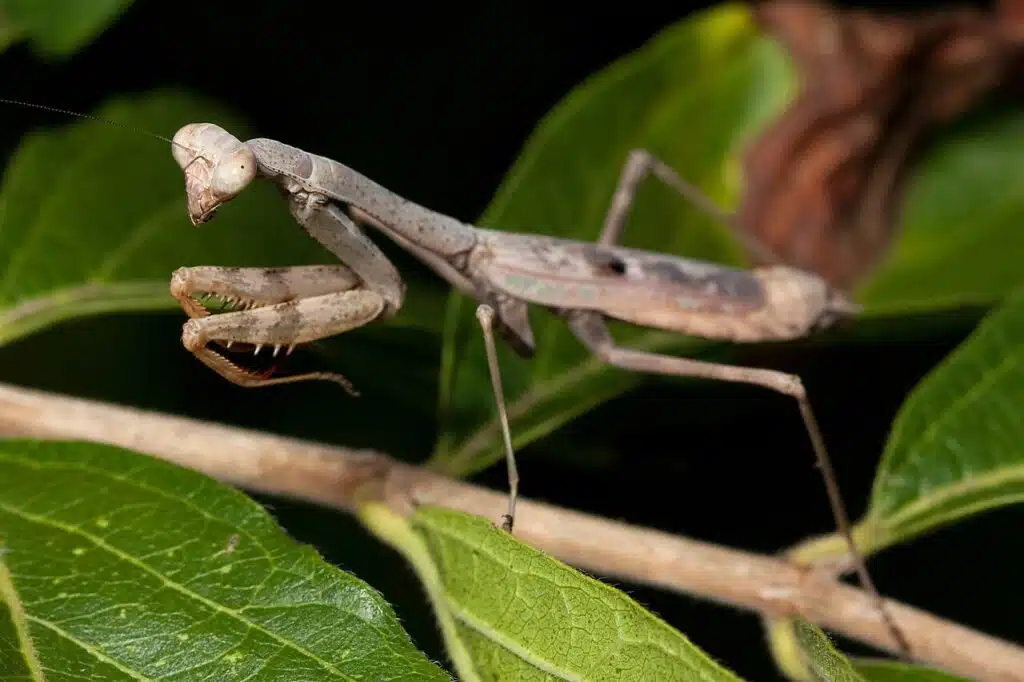
Its name is inspired by its common nature in South Carolina, a state where the bug has a state insect status.
Carolina Mantises come in different colors, from gray to green. These colors can be adapted to the environment as the bug grows.
Unlike other mantises, The Carolina Mantis can also show eyespots on its wings.
2. Chinese Mantis
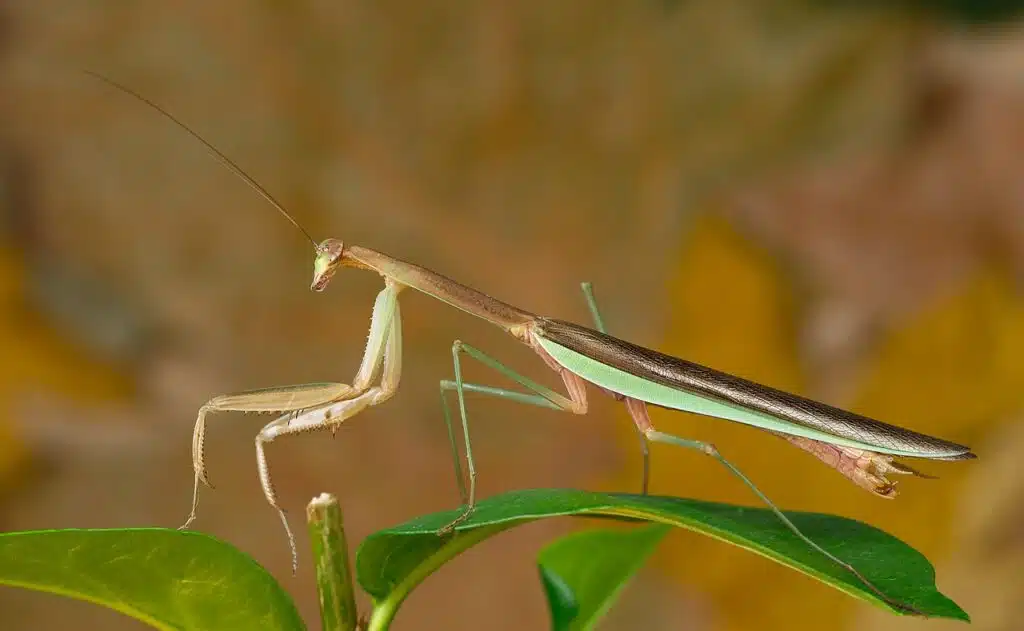
Chinese Mantis (Tenodera sinensis) are among the largest species found in North America. A common presence in the Northeastern parts of the continent, these bugs grow to a size of over 4 inches.
An introduced species in the United States, Chinese Mantids are known for feeding on insects and spiders.
They are also seen as prey for various hornets, birds, and even other species of Praying Mantises.
Varying colors are specific to the Chinese Mantis. Brown and green colors are specific to this species.
Surviving up to a year, The Chinese Mantis lays hundreds of eggs in the summer.
The eggs of the species are laid by the female, in a sac known as an ootheca.
3. European Mantis
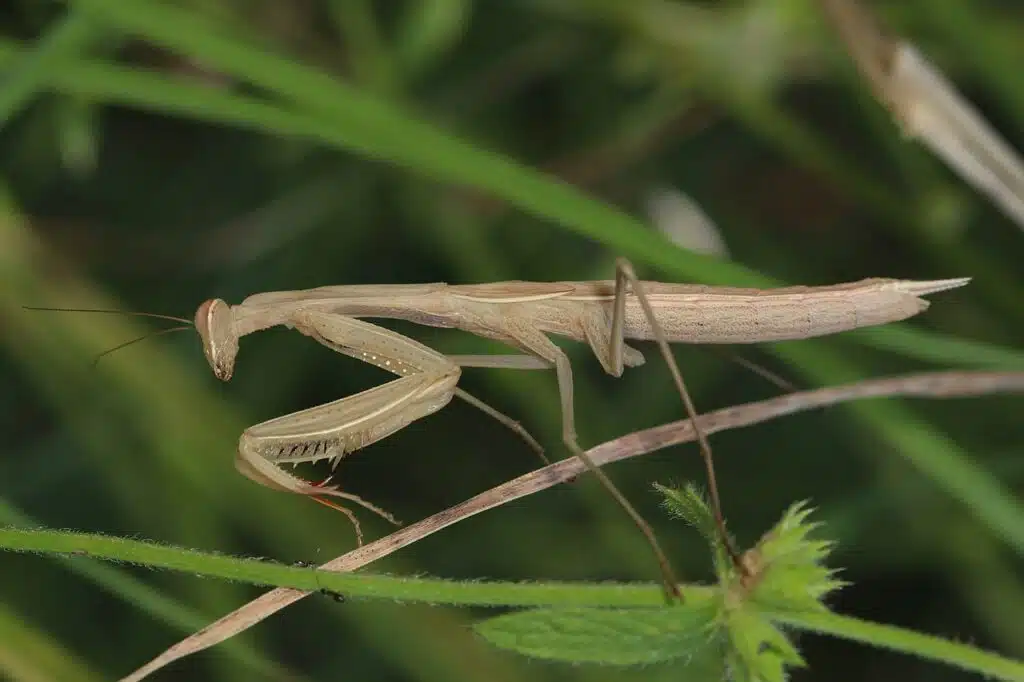
The European Mantis (Mantis religiosa) has an introduced status in North America.
Its size is similar to the size of most mantids in North America as it measures up to 3 inches.
Female European Mantises are likely to be larger than their male counterparts.
This is a species with varying colors such as green and brown. But it also comes in rare yellow and black colors as well.
As a black praying mantis, there are no direct data to show it has a competitive camouflaging advantage over other colors.
These types of bugs are predatory. They eat other bugs such as grasshoppers but can also catch some types of cockroaches.
Further Reading:
4. Arizona Mantis
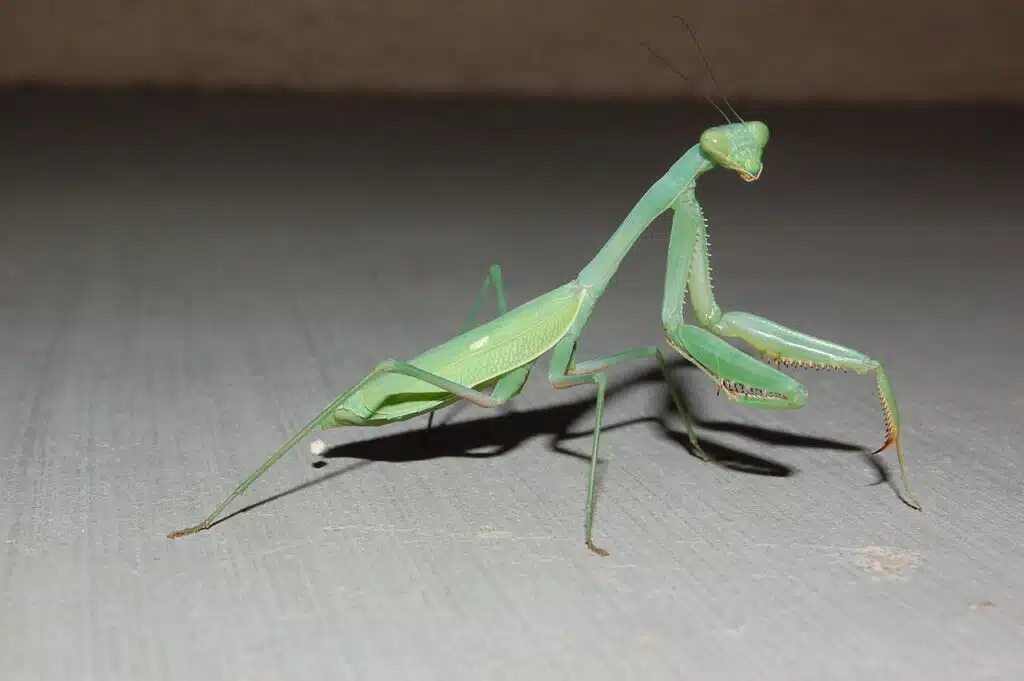
Arizona Mantis (Stagmomantis limbata) are a common presence in Southern and Southwestern US territories.
This is a distinct species that grows to 3 inches and which has a presence in almost fully arid habitats.
It can live in dry areas and areas with scarce vegetation.
The coloring of the female is one of the distinctive traits of this species. Arizona Mantis females have a green dorsal color and yellow ventral coloring.
Wooded areas around California and places around water sources are the areas where this version of the female can be seen.
5. California Mantis
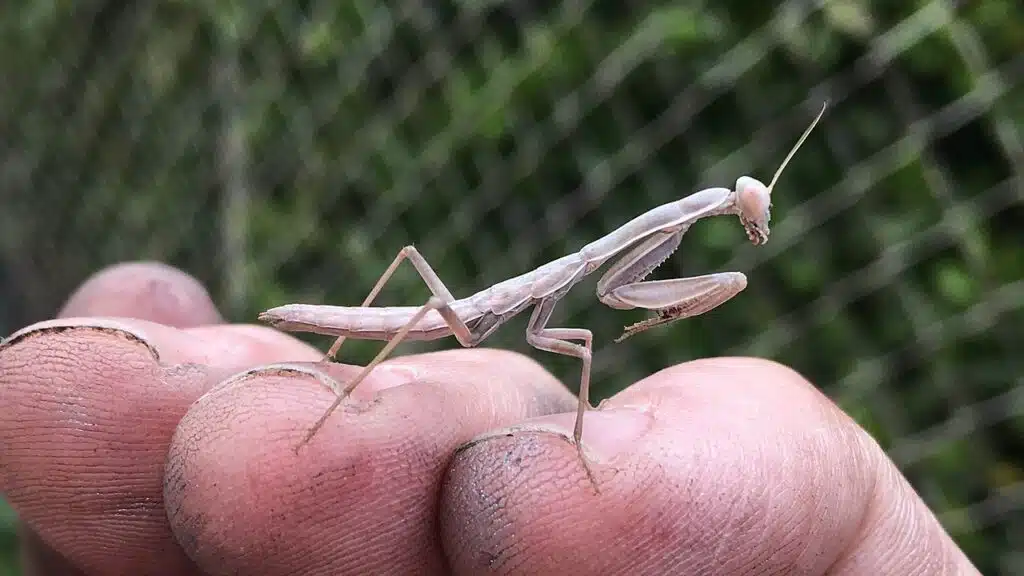
California Mantises (Stagmomantis californica) live in Southern California in high numbers and across the state in lesser numbers.
They can inhabit lowlands as well as areas at a high elevation of up to thousands of feet.
Like Arizona Mantdis, California Mantids can also come with a bright ventral color combined with a green dorsal color.
Orange inner legs are seen on this species.
The California Mantis is a species that grows to several inches whereas females are larger.
A common sight on chaparral vegetation, the female California Mantis uses shrubs and grasses to lay an oothecal in.
While living in a warmer state, The California Mantis cannot survive winters and never reach a lifespan of 1 year.
6. Narrow-winged Mantis
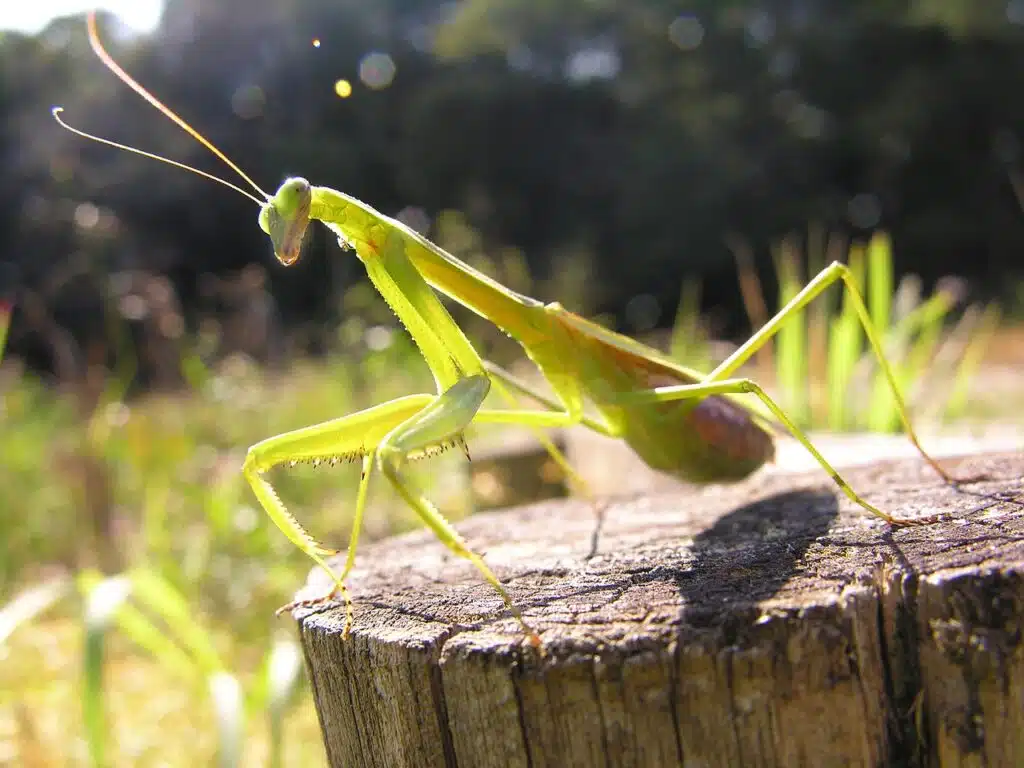
A base green color is specific to The Narrow-winged Mantis (Tenodera angustipennis).
This species is native to Asia where it can be found in India, Japan, and other countries.
It has also made its way to The East Coast of The US as well as to Hawaii.
These bugs measure around 3 inches with only the largest females measuring up to 3.3 inches.
Large females are responsible for laying eggs and they use a gray to brown ootheca to lay clusters of eggs.
These eggs can hatch within 10 days and then molt multiple times to the final color, which is often mostly green with brown dorsal areas.
7. Mediterranean Mantis
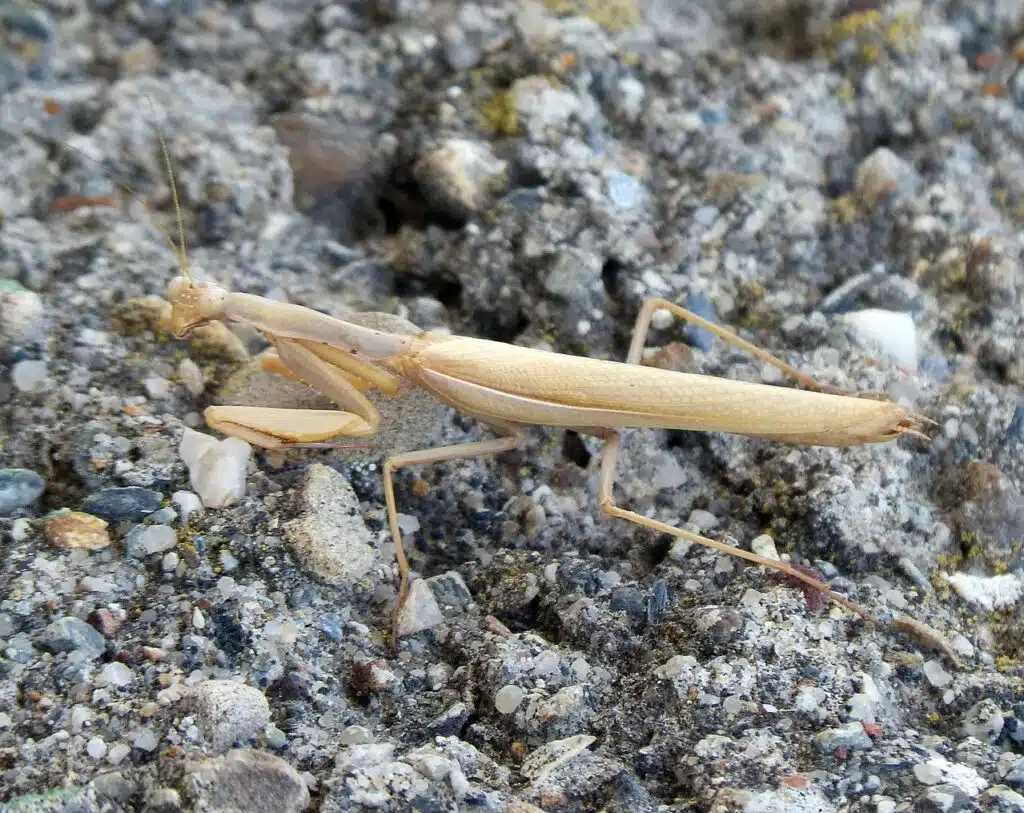
Mediterranean Mantis (Iris oratoria) have a reduced size among introduced species of North America. They only grow to a maximum of 2.5 inches.
This European-origin bug is known for its aggressive behavior, despite being smaller than other mantids in North America.
It uses ambushing techniques and it also resorts to cannibalism when hungry.
Mediterranean Mantids have a green color but they exhibit large violet or dark violet eyespots when their open their wings.
This self-defense method is also specific to other mantids with eyespots. However, the violet color of the eyespots makes the species distinct and easier to identify when attempting to fly.
8. American Grass Mantis
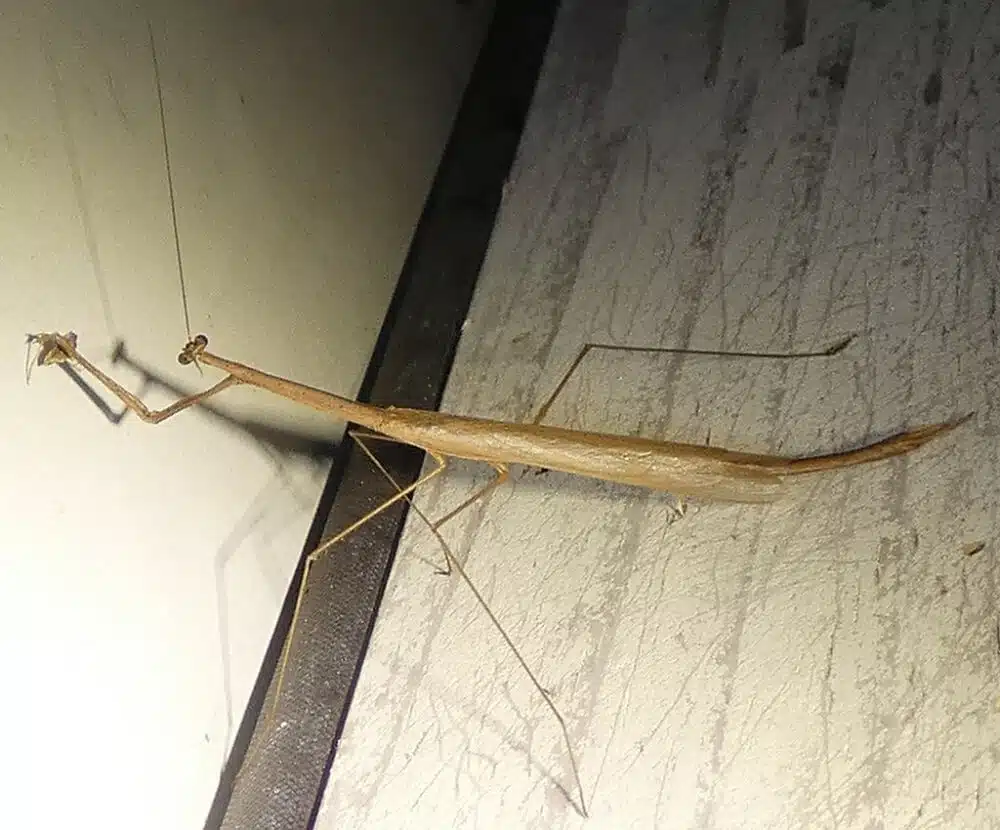
American Grass Mantis (Thesprotia graminis) are among the smallest species of the genus found in North America.
This bug grows to an average length of 1.5 inches. It also has a thin stick-like body which may often confuse those trying to identify it.
A dark brown or brown-to-gray color is specific to this species. The American Grass Mantis is among the species that use its narrow body as camouflage.
This narrow body allows it to be overlooked when positioned on grass.
Various small flies are part of their diet. Moths in the Southeast are also often eaten by a bug.
A Southeastern US distribution is specific to the American Grass Mantis.
9. Grizzled Mantis
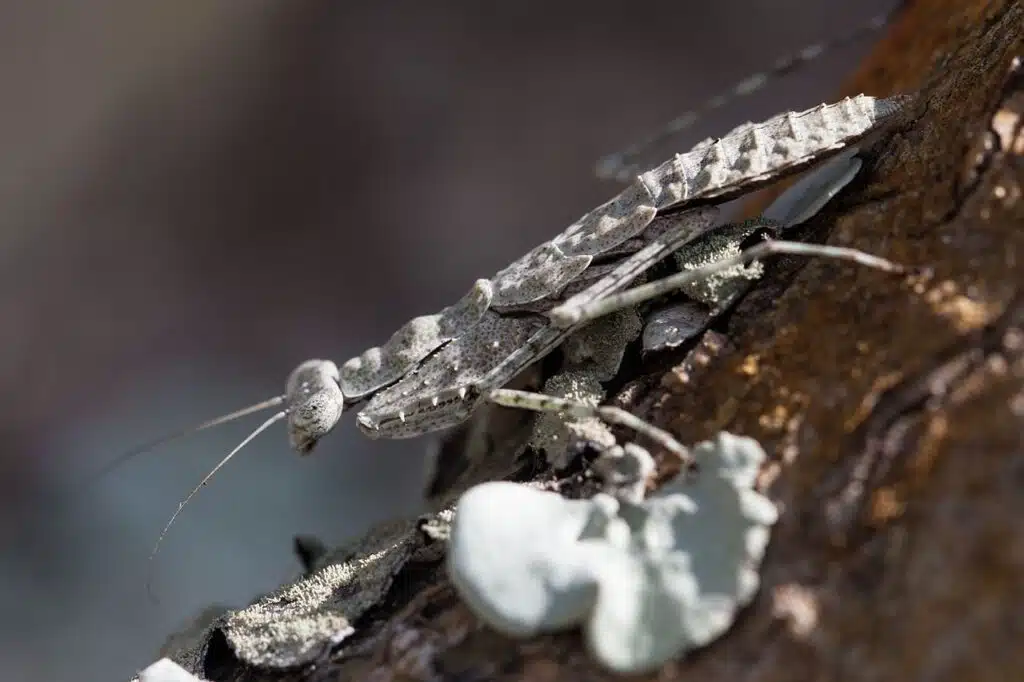
With widespread Southeastern US distribution, Grizzled Mantids (Gonatista grisea) have a unique appearance.
It takes on a mottled green color that resembles tree lichen. Its camouflaging colors make it look distinct from most Praying Mantids which have uniform green coloring.
Grizzled Mantises are also some of the smallest types of Praying Mantis in the United States.
Only the largest bugs of the species measure up to 1.5 inches, while others measure around 1.2 inches.
This species is commonly seen in the Southeastern US areas with scrub hickory.
The green and gray molted colors of the species help it camouflage itself on the bark of this hickory.
10. Agile Ground Mantis
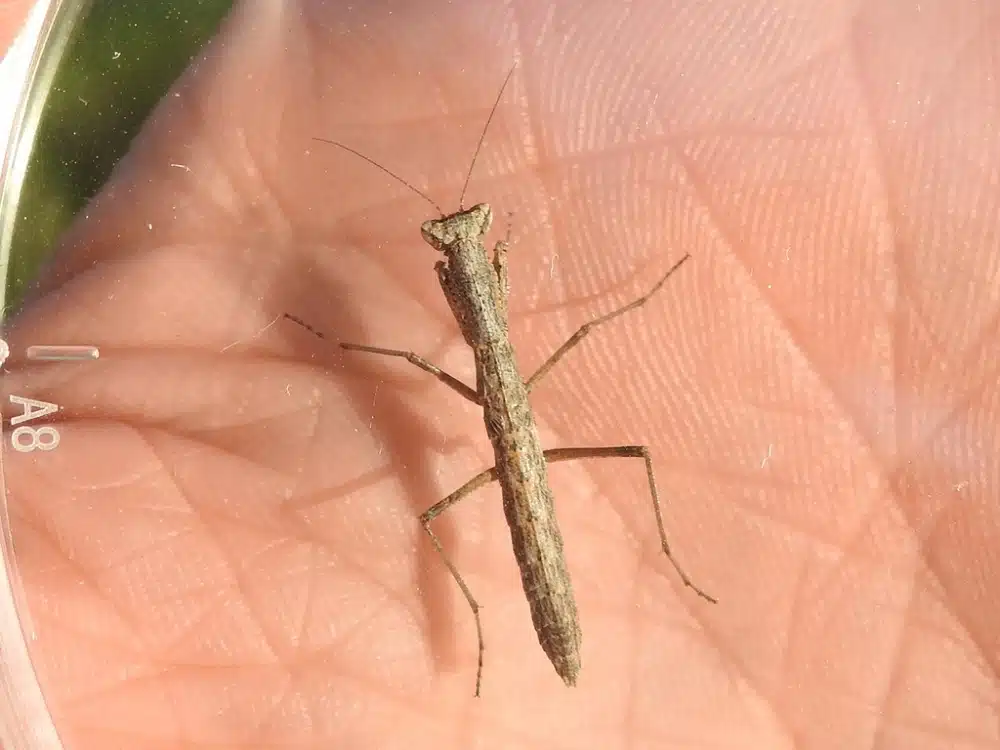
West Coast territories are known distribution areas of The Agile Ground Mantis (Litaneutria minor).
This is a species known for its dark brown and gray coloring. A dark Praying Mantis, The Agile Ground Mantis takes on the color of the soil and of dead leaves for camouflage.
While not as narrow-bodied as other small mantids, The Agile Ground Mantis is a species that is short. Only the largest females of the species reach the longest size of 1.2 inches.
Only surviving up to early fall weeks, this specie also lays a low number of eggs.
Female Agile Ground Mantises lay up to 20 eggs in an oothecal compared to 200-300 eggs laid by females of other Praying Mantids.
They lay eggs within 2 weeks after mating.
11. Northern Grass Mantis
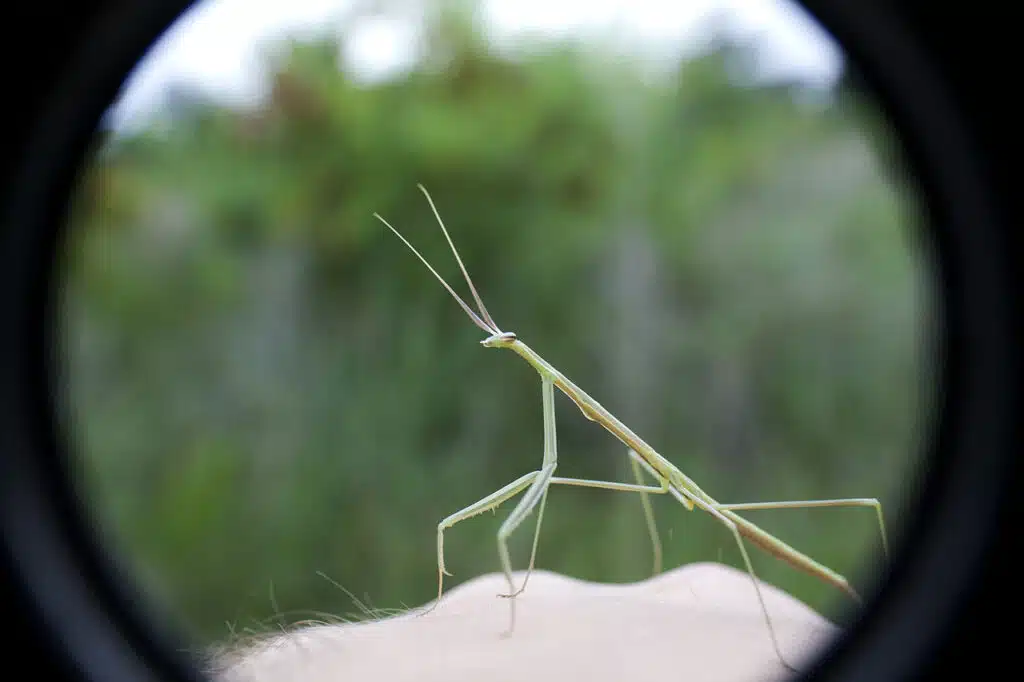
Northern Grass Mantids (Brunneria borealis) get their names from the grasslands and tall grass areas they inhabit.
Green color and a thin stick-like body are specific to these bugs.
The Northern Grass Mantis is a species where all bugs are female and can reproduce through parthenogenesis.
Females don’t need to reproduce to lay eggs. An average Northern Grass Mantid is a female measuring around 3 inches.
A genetically similar female is then born from an egg from the unmated female.
These bugs are known to live in grass. They feed on similarly-looking bugs, but of other species. A preference towards walkingstick bugs is noted for the species.
12. Obscure Ground Mantis
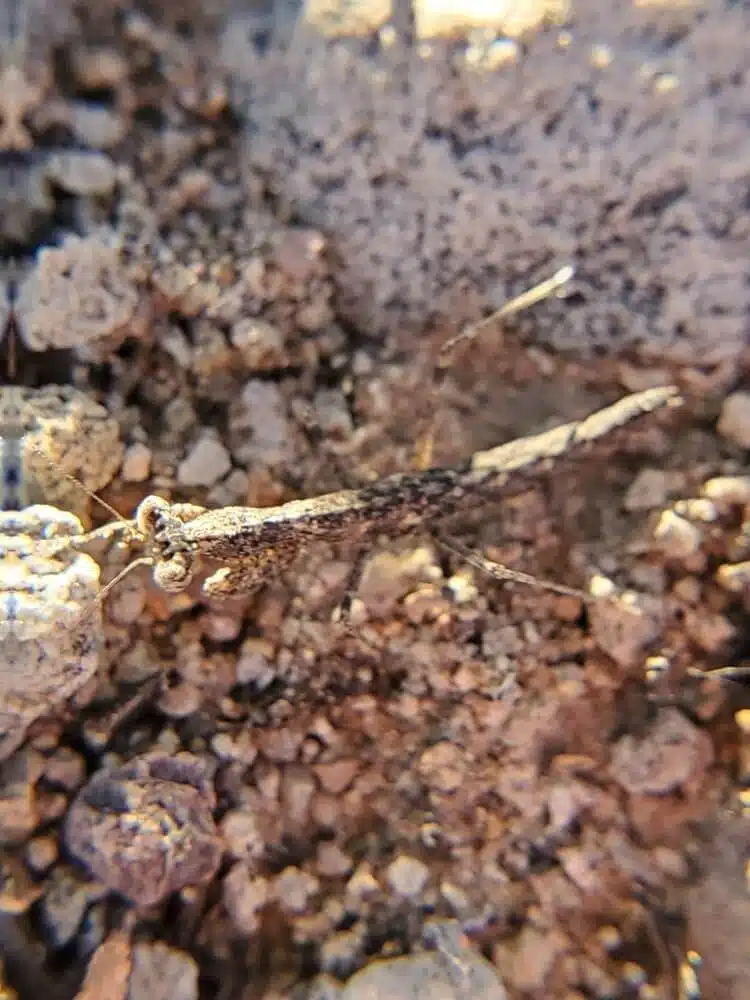
Obscure Ground Mantises (Litaneutria ocularis) are one of the rare types of Praying Mantises in North America.
They only live in the extreme Southern territories of California and Texas.
A ground-dweller, this type of Praying Mantis has light brown, tan, or gray coloring. It comes in both light and brown-gray.
The mottled gray coloring is also specific to The Obscure Ground Mantis.
Much of its coloring is influenced by its habitat.
Present in semi-arid regions, this species is known for its capacity to blend in. For example, the tan Obscure Ground Mantis prefers to live on dry vegetation.
13. Texas Unicorn Mantis
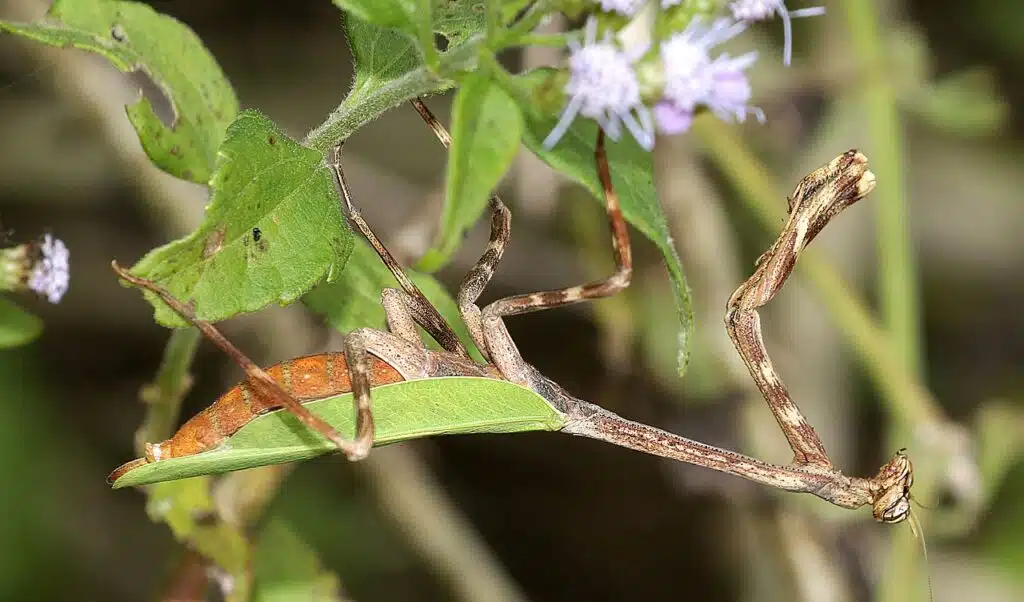
The Texas Unicorn Mantis (Pseudovates chlorophaea) is another species of rare Praying Mantises in The US.
Southern borders of Southern states are the main distribution areas of Texas Unicorn Mantids.
The species is also one of the rare types of banded Praying Mantises.
Its legs are brown and yellow banded.
The body of The Texas Unicorn Mantis is stick-like. Its shape and colors help the species camouflage itself.
Insects, moths, and butterflies are among the typical prey of the species.
14. Slender Prairie Mantis
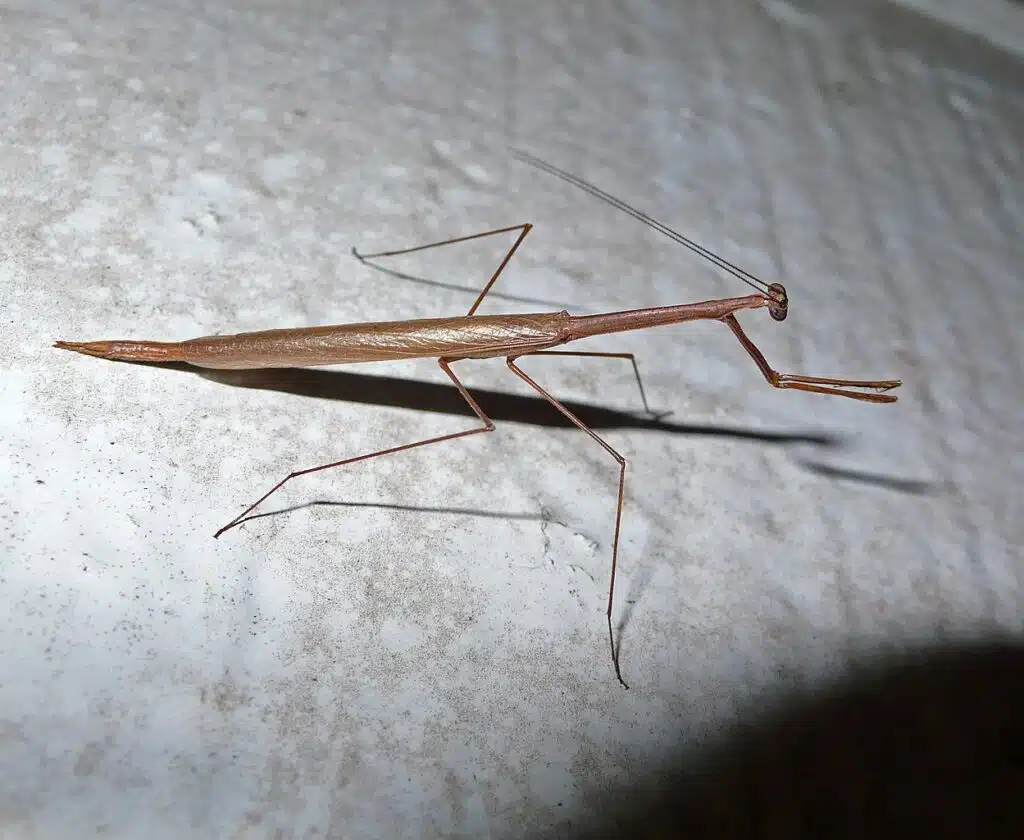
The black, gray, and green coloring is specific to The Slender Prairie Mantis (Oligonicella scudderi).
This species is mostly present across Texas as well as along The Great Plains.
A small species, Slender Prairie Mantises grow to a size between 1 and 1.4 inches.
A stick-like body shape is specific to The Slender Prairie Mantises, as its name suggests.
This species tends to run away into vegetation when spotting people.
Slender Prairies Mantids can sometimes be spotted on Little bluestem grass, a prairie plant it often takes the color of.
15. Giant Asian Mantis
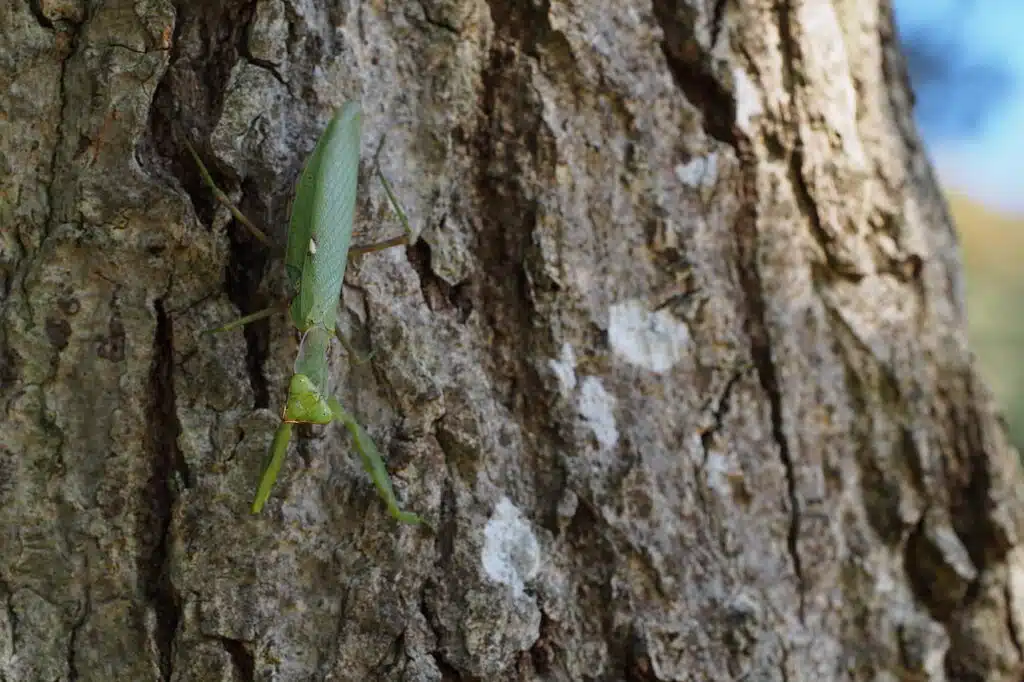
A light green color is specific to The Giant Asian Mantis (Hierodula patellifera). This species also comes in darker green.
Female Giant Asian Mantids are slightly larger than males, growing to a maximum length of around 3 inches.
These bugs can be found in trees, on shrubs, or in other areas with dense vegetation at different altitudes.
Woodlands and the edges of woodlands are among the main distribution areas of the species.
The Giant Asian Mantis is one of the main cicada predators.
16. Slim Mexican Mantis
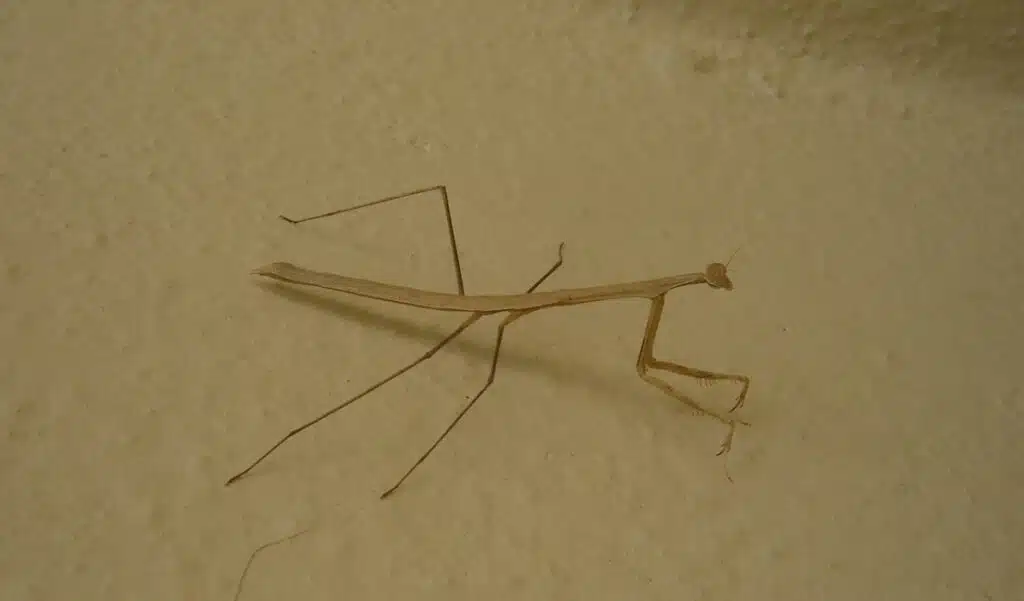
Tan, light brown, and dark brown coloring is specific to The Slim Mexican Mantis (Bistanta mexicana).
Native to Mexico, this species is also present in Southern areas of Texas.
Its largest recorded size of 5 inches is atypical as these Praying Mantids measure an average of 2-3 inches.
A brown base color and a thread-like body make this bug resemble sticks.
17. Larger Florida Mantis
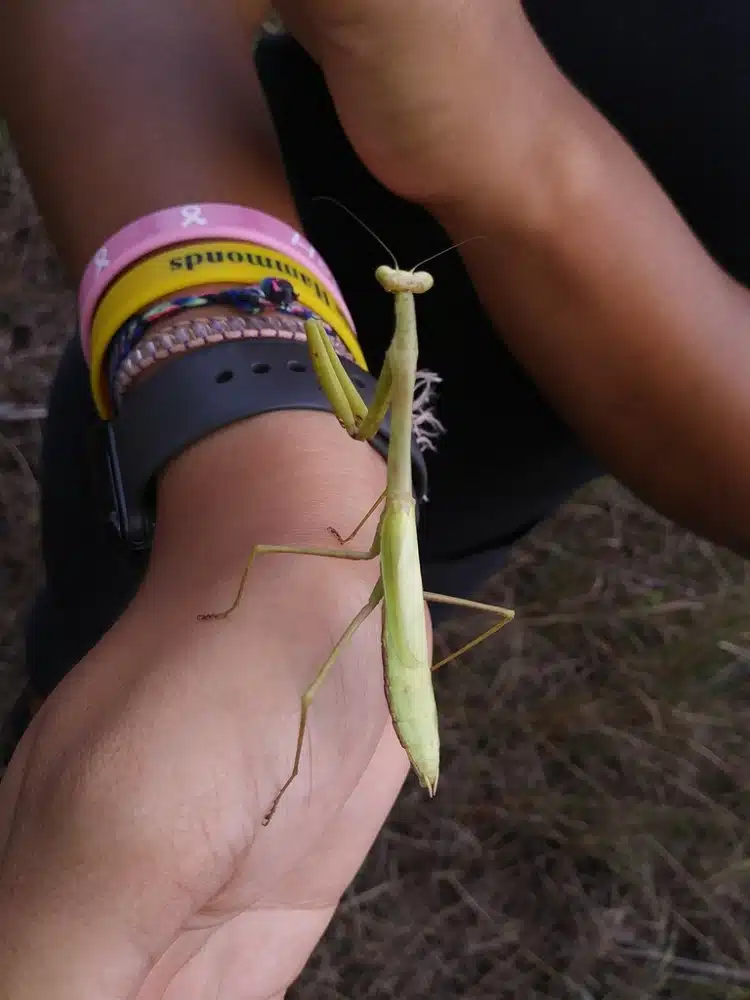
The Southeastern United States is the main distribution area of The Larger Florida Mantis (Stagmomantis floridensis).
This is a species that comes in multiple colors. Grey, mottled gray, black, and yellow colors are all seen across Florida.
Unlike many other gray Praying Mantises, The Larger Florida Mantis is a species that comes with contrasting green legs.
In turn, yellow mantises are all-yellow while green mantises of the species are all green.
This species can grow to a size of up to 5 inches.
18. Pacific Ground Mantis
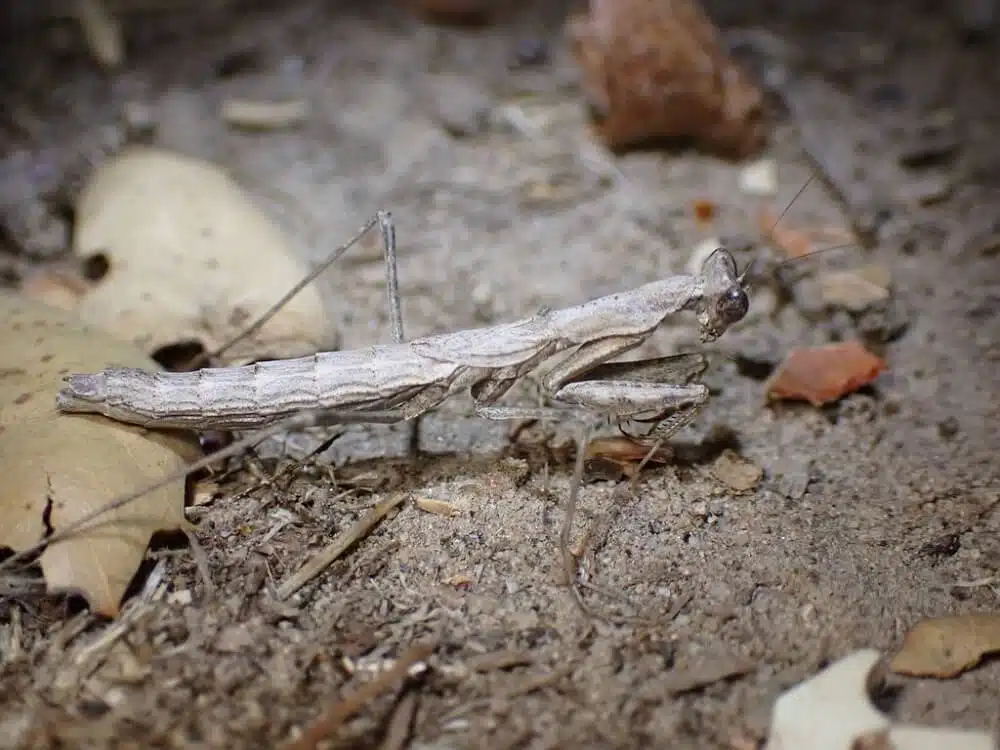
The small Pacific Ground Mantis (Litaneutria pacifica) is native to North America.
A species seen in the semi-arid climates in Southern regions of the US, The Pacific Ground Mantis grows to a size between 1 and 2 inches.
Bright neutral colors are mostly specific to the species, according to its habitat.
It comes in pale yellow, brown, and gray. In rare cases, The Pacific Ground Mantis can also be black.
A common mottled gray common makes the species difficult to spot on the dry lands it lives on.
Pacific Ground Mantids have wings but are poor fliers.
19. South African Mantis
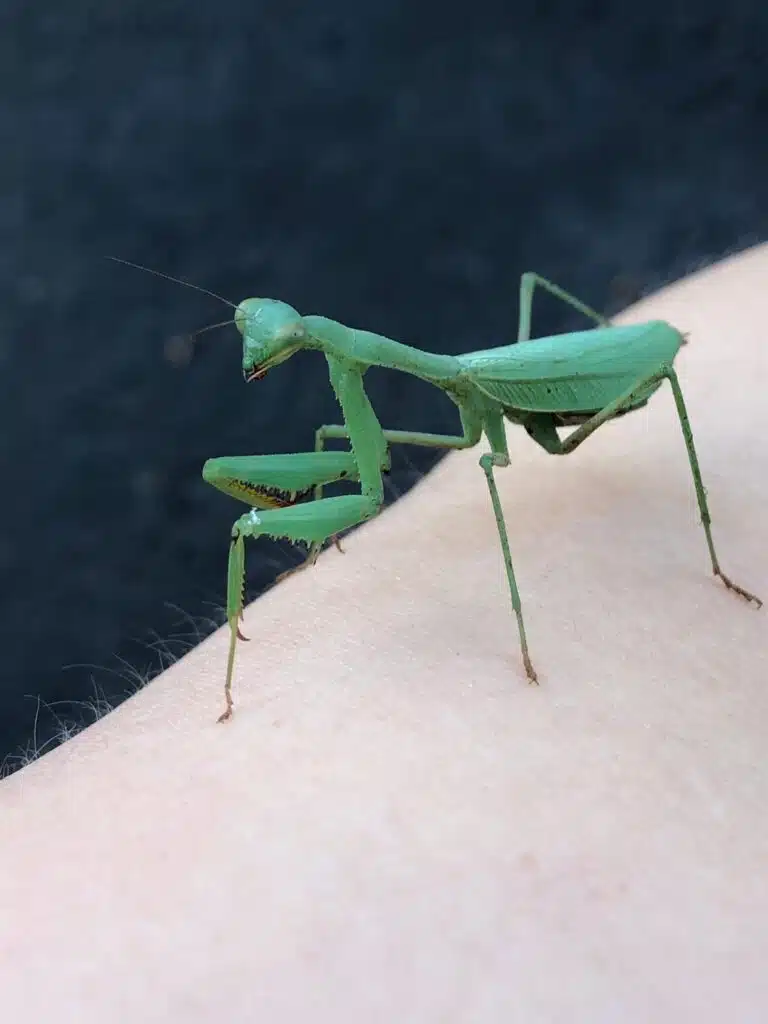
Native to South Africa, this species (Miomantis caffra) has spread to New Zealand and The United States.
It grows to a size between 2 and 2.3 inches and it has mostly green bodies and wings.
Female South African Mantids can reproduce by mating or on their own, through parthenogenesis.
They lay an oothecal with tens of eggs in vegetation after mating or on their own.
Generally living under leaves, the females of the species also show cannibalistic traits.
They can eat offspring or they can eat males, typically soon after mating.
20. Asian Jumping Mantis
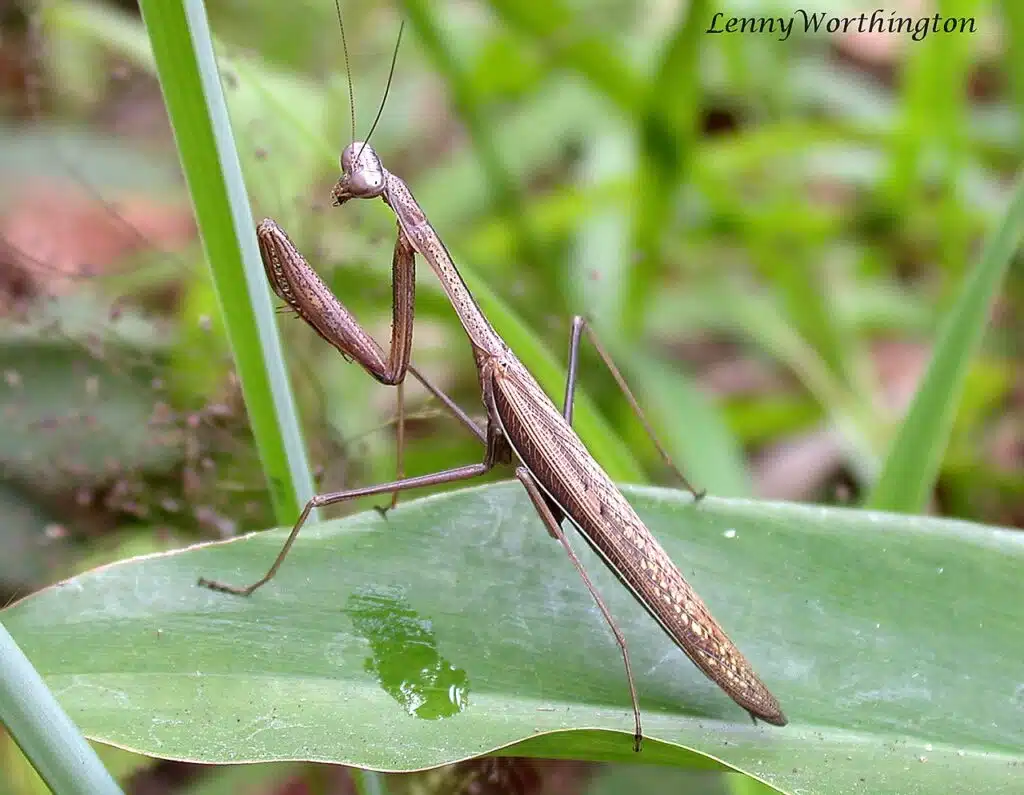
The Asian Jumping Mantis (Statilia maculata) is native to Asia and Eastern parts of Europe.
This species grows to an average size of 2-3 inches and it comes in different colors.
Gray, dark brown, or brown-to-black are its main colors. All of the colors the species comes in are specific to its body and its wings as its legs are banded.
Yellow and brown or yellow and gray bands are mostly specific to its legs.
21. Arizona Tan Mantis
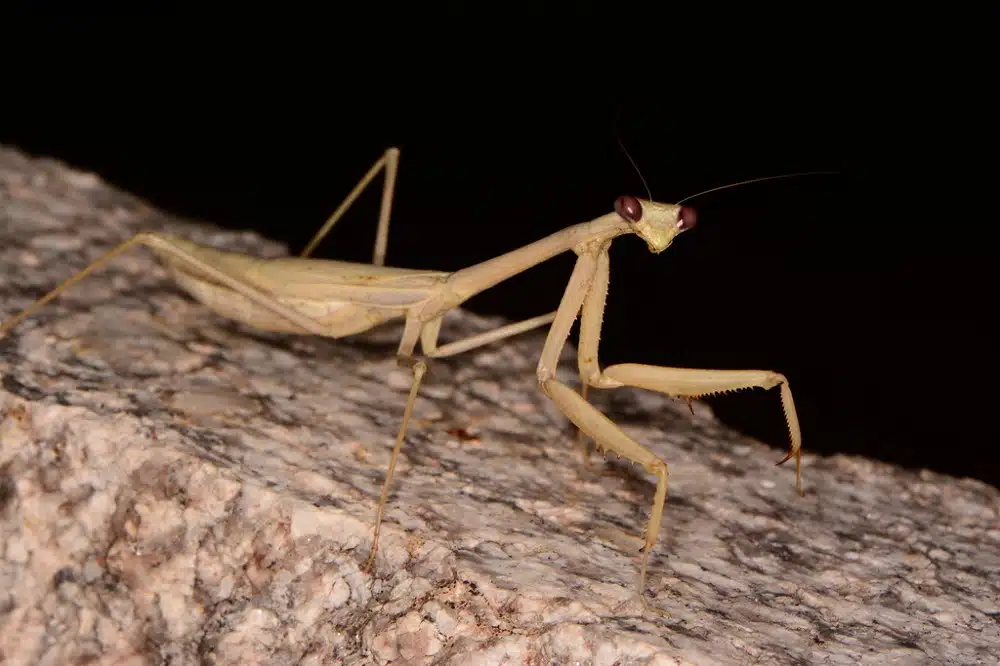
The Arizona Tan Mantis (Stagmomantis gracilipes) is native to Arizona state and to the Southwestern US territories.
Its light tan color inspires the name of the species which lives in semi-arid climates.
A size of 1-2 inches is specific to the adult Arizona Tan Mantis. The species has a thread-like body shape as well.
Thin and similar to a stick, Arizona Tan Mantises may survive up to a year. The females might die soon after laying eggs.
They attach an oothecal to vegetation, typically above the ground.
22. Purple-winged Mantis
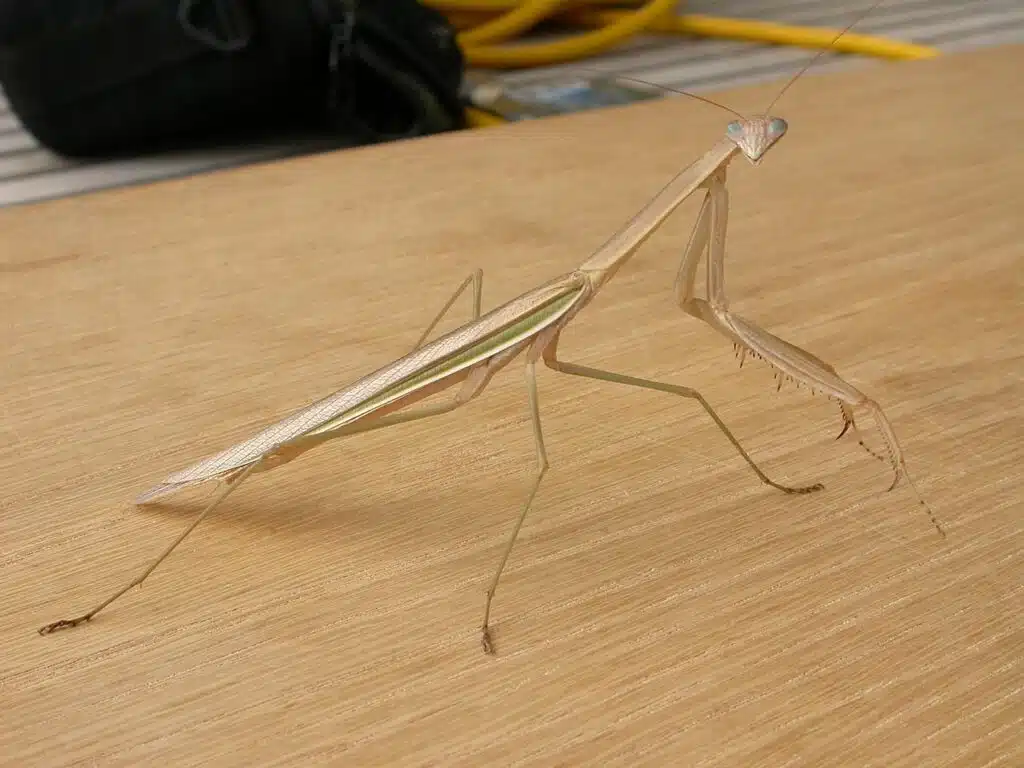
Tan, brown, gray, green, purple, and gold are the specific colors the Purple-winged Mantis (Tenodera australasiae) is seen in.
This is a species known for its long body which can measure anywhere between 3 and 5 inches.
Purple-winged Mantises have a stick-like appearance which helps them camouflage themselves in vegetation.
An Australian native, The Purple-winged Mantis can fly, but over short distances.
This is also a highly aggressive species known for preying on large bugs and for showing occasional cannibalistic traits.
23. Horned Ground Mantis
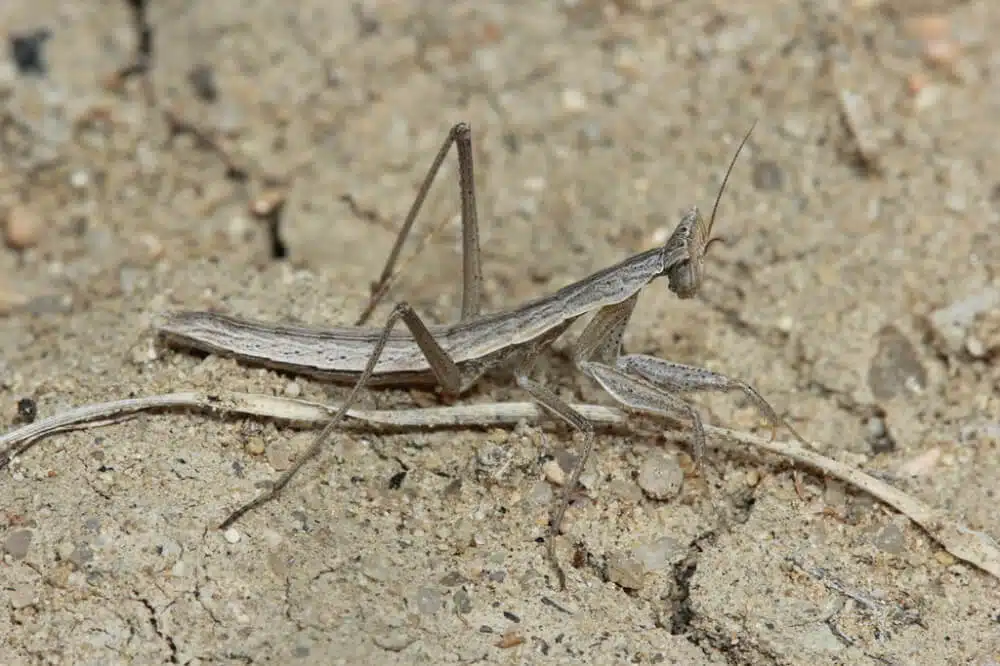
Gray, green, and brown colors are among the typical colors The Horned Ground Mantis (Yersiniops solitarius) is seen in.
Found in Southern Arizona, The Horned Ground Mantis has 2 small projections on its head that resemble horns.
A species that take on the color of its habitat, this Praying Mantis can live on the ground, among leaves, or higher above the ground, in vegetation.
As adults, these Praying Mantises are among the smallest in The US as they only grow to an average size of 1 inch.
24. Arizona Unicorn Mantis
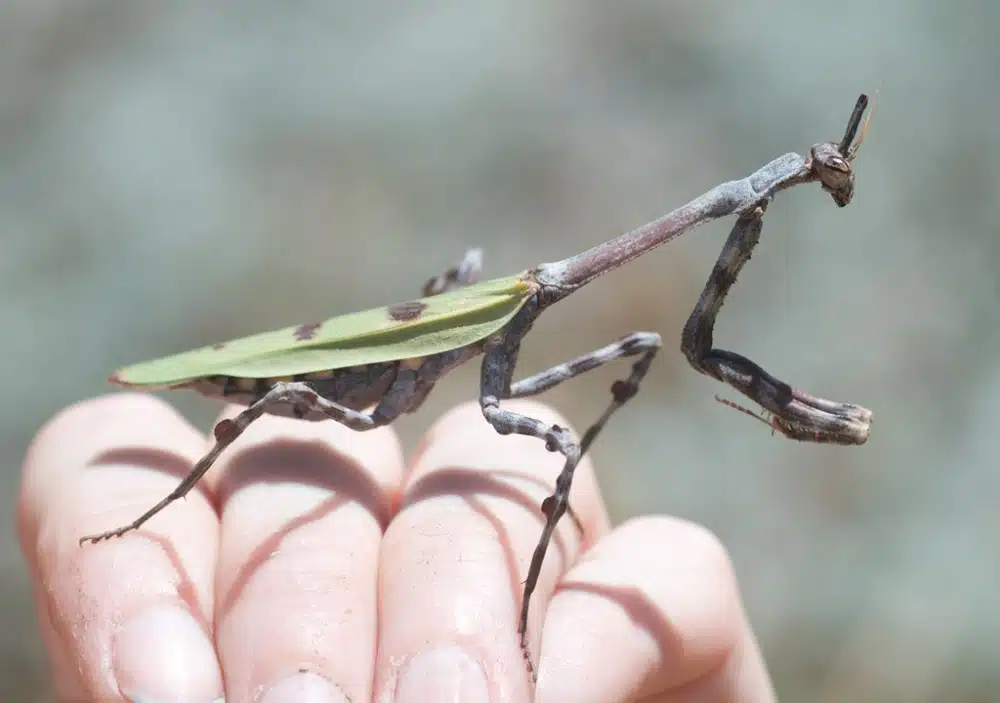
A species native to Arizona, this type of Praying Mantis (Pseudovates arizonae) is known for its camouflaging shape and colors.
It has a thin stick-like body, thin and curbed front raptorial legs, and long banded rear legs.
Brown and gray bands are specific to this species. Its body is also rust-brown and gray. Resembling twigs, this species uses its camouflaging appearance as a predator.
Small physical differences between males and females make for easier identification. Females are larger while males have longer antennae.
25. Skinner’s Ground Mantis
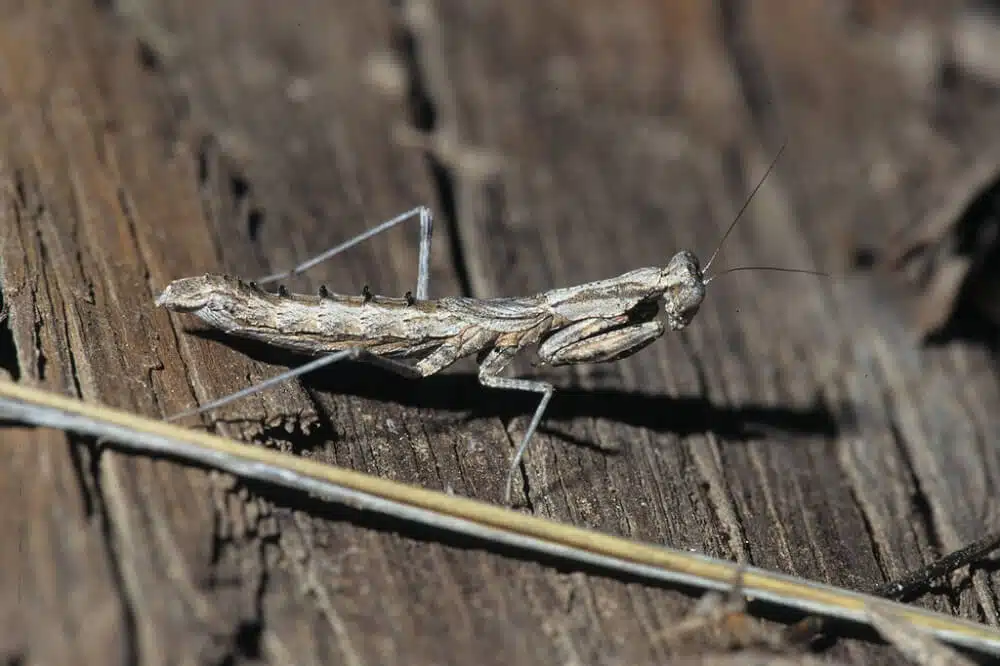
The West Coast is the distribution area of Skinnier’s Ground Mantis (Litaneutria skinneri). However, the Southwest is where the species is mostly present.
This type of Praying Mantis has bright neutral colors such as bright gray and tan. Growing to a size of 1-2 inches, the species takes on the color of its habitat.
Females are larger but males have longer thin antennae.
Commonly living on the ground, under leaves, or on plants and grass, this type of Praying Mantis also has wings but it can’t fly far.